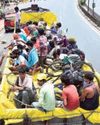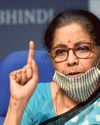The BJP wrests power from the Congress in a keenly fought election marked by a few upsets.

IN THE SINGLE-PHASE ELECTION TO THE Himachal Pradesh Assembly on November 9, which registered the highest ever turnout (75.28 per cent) in the history of the State, the electorate of Himachal Pradesh voted the Bharatiya Janata Party (BJP) to power. The BJP’s return to the seat of governance in the State after a gap of five years was not a surprise because no party has managed to win elections successively and retain the reins of power since 1985. Yet, the elections to the 68member State Assembly were keenly contested between the incumbent Congress and the opposition BJP. While six-timeCongressChiefMinisterVirbhadra Singh led his party’s campaign, his political adversary and former Chief Minister Prem Kumar Dhumal was the face of the BJP.
Compared to the number of high-octane rallies in Gujarat, Prime Minister Narendra Modi addressed only seven in the State, leaving most of the campaigning to Dhumal. The high-decibel campaign in Gujarat was in contrast to the largely subdued campaigning in Himachal Pradesh.
While the BJP secured a thumping majority, its Chief Ministerial candidate lost, as did the party’s BJP State president, Satpal Singh Satti. Dhumal lost from Sujanpur by 2,933 votes. The winner, Rajinder Singh Rana of the Congress, was once his protege. He had successfully contested as an independent in 2012 too.
Dhumal’s relative and former Speaker Gulab Singh Thakur also lost. The defeat of the BJP heavyweights in the face of anti-incumbency and a decisive two-thirds majority was inexplicable.
هذه القصة مأخوذة من طبعة January 5, 2018 من FRONTLINE.
ابدأ النسخة التجريبية المجانية من Magzter GOLD لمدة 7 أيام للوصول إلى آلاف القصص المتميزة المنسقة وأكثر من 9,000 مجلة وصحيفة.
بالفعل مشترك ? تسجيل الدخول
هذه القصة مأخوذة من طبعة January 5, 2018 من FRONTLINE.
ابدأ النسخة التجريبية المجانية من Magzter GOLD لمدة 7 أيام للوصول إلى آلاف القصص المتميزة المنسقة وأكثر من 9,000 مجلة وصحيفة.
بالفعل مشترك? تسجيل الدخول

How Not To Handle An Epidemic
The lockdowns were meant to buy time to put in place appropriate health measures and contain the coronavirus’ spread, but they have failed to achieve the objective and heaped immense misery on the marginalised sections of society. India is still in the exponential phase of the COVID-19 infection and community transmission is a reality that the government refuses to accept.

Tragedy on foot
As the COVID-19-induced lockdown cuts the ground beneath their feet in Tamil Nadu, thousands of migrant workers are trudging along the highway to the relative safety of their upcountry homes.

Sarpanchs as game changers
Odisha manages to keep COVID-19 well under control because of the strong participation of panchayati raj institutions and the community at the grass-roots level under the leadership of Chief Minister Naveen Patnaik.

Scapegoating China
As the COVID-19 death rate spikes and the economy tanks in the United States, Donald Trump and his advisers target China and the World Health Organisation with an eye to winning the forthcoming presidential election.

New worries
Kerala’s measured approach to the pandemic and lockdown has yielded results. But it still has to grapple with their huge economic impact on its economy, which it feels the Centre’s special financial relief package does little to alleviate.
No love lost for labour
Taking advantage of the lockdown and the inability of workers to organise protests, many State governments introduce sweeping changes to labour laws to the detriment of workers on the pretext of reviving production and boosting the economy.

Capital's Malthusian moment
In a world that needs substantial reorienting of production and distribution, Indian capital is resorting to a militant form of moribund neoliberalism to overcome its current crisis. In this pursuit of profit, it is ready and willing to throw into mortal peril millions whom it adjudicates as not worth their means—an admixture of social Darwinism born of capital’s avarice and brutalism spawned by Hindutva. .

Understanding migration
When governments and their plans are found to be blatantly wanting in addressing reverse migration, exercises such as the Ekta Parishad’s survey of migrant workers throughout India can be useful to work out creative long-lasting solutions.

Waiting for Jabalpur moment
The Supreme Court’s role in ensuring executive accountability during the ongoing lockdown leaves much to be desired. Standing in shining contrast is the record of some High Courts.

An empty package
The Modi regime, which has been unable to control the COVID-19 infection, restore economic activity and provide relief to millions exposed to starvation, trains its sights on Indian democracy, making use of the panic generated by fear and a lockdown that forecloses paths of resistance.